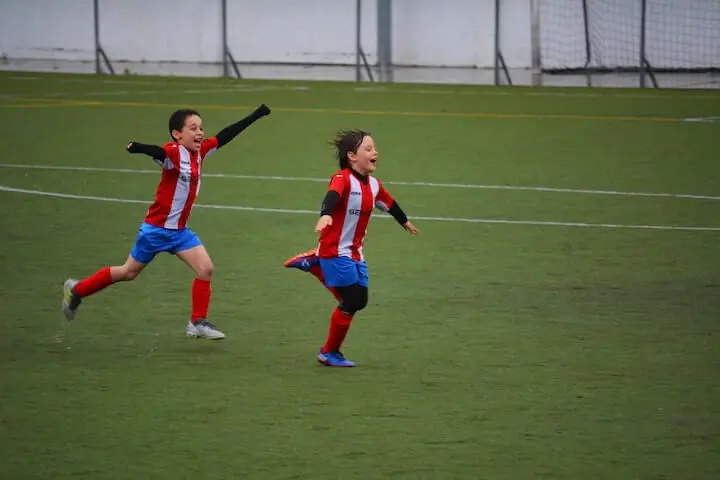8v8 Soccer Formations (6 Fantastic Options)
Young players start out playing as part of smaller teams on scaled-down fields.
Kids in the under 11 and under 12 age categories compete in 8v8 soccer (including the goalkeeper) games under the US Youth Soccer regulations.
At this stage of their sporting lives, youth players are not quite physically or technically developed enough to participate in an 11v11 game on a full-size regulation field.
Therefore, coaches need to adapt their coaching strategies to this in order to teach players positioning, tactics, and core skills in controlled environments more suited to their level.
Using effective 8v8 soccer formations is a critical part of the process.
Here are some to consider...
Best 8v8 Soccer Formations
With just three fewer players than a full 11, there are several effective 8v8 soccer formations you can use to set up your team.
Depending on the style of play you want to implement and the players at your disposal, certain shapes may be more effective than others.
Some are attack-oriented, others offer defensive solidity, while several options suit a more balanced setup.
While it might be ambitious to teach all of these formations to your team, you could consider switching between two, or even three if your players are up to it.
Let’s break down the best 8v8 soccer formations, including the pros and cons.
a. 2-3-2 Formation
The 2-3-2 formation offers exceptional balance with two central defenders and three-player midfield, and dual strikers.
The key to success in this shape is utilizing the midfield to provide width and central support.
Both wingers should stay wide, only tucking in to offer defensive cover or to exploit gaps in the opposition defense.
The center midfielder (CM) must remain disciplined, spending the majority of their time in the center circle. The CM can occasionally venture forward or drop back into the defensive line when necessary.
Goal-hungry strikers should look to get on the end of long balls and crosses from wide areas.
If your team is defending a lead late into the game, consider pulling one striker back to create a more compact midfield.
PROS | CONS |
|---|---|
The midfield trio uses the full width of the field, enabling chance creation from all angles. | The CM must remain disciplined to offer support in attack and defense, which can be difficult for young players. |
Two central defenders hold their position for the entire game, limiting clear-cut chances for opponents. | A lot of pressure lies on the wingers’ shoulders to create chances and score goals. |
Dual strikers mean the opposition defenders are almost always occupied. | This formation is vulnerable against teams who sit back and look to spring counterattacks. |
b. 3-2-2 Formation
This is one of the most popular 8v8 formations among defense-first coaches.
The three-player backline is tough to break down, especially considering the reduced size of the field.
Another advantage of having three at the back is ball retention, since the opposition is unlikely to have three attackers.
It’s generally a good idea to deploy a central defender who is comfortable on the ball and two fullbacks who are happy to keep possession for long periods.
Both CMs cover a lot of distance and put in defensive work throughout the game.
This allows the fullbacks to roam forward where they often enjoy a lot of space to whip in crosses or shoot from a distance.
Similar to a 2-3-2, the strikers are essentially double number 9s, working together to find openings and get on the end of crosses.
PROS | CONS |
|---|---|
The three-player backline creates a solid defensive spine that’s difficult to penetrate. | This approach may be difficult to execute for players with limited technical abilities. |
This is an excellent shape for possession-based teams that build from the back. | Without a quality centerback, turnovers in dangerous areas are a major threat. |
Attacking fullbacks provide excellent balance to the team, creating space on the wings. | If the opponents play with wingers, the fullbacks will find it difficult to attack. |
c. 3-3-1 Formation
The 3-3-1 is an excellent option for teams with talented players in central positions.
Since there is only one striker, it’s often best to play your best attacker up front.
Although the sole striker receives support from the wingers and CM, they may be outnumbered for large parts of the game.
Therefore, having the ability to beat a defender in a 1v1 and create chances solo is a huge advantage.
Because this shape has two fullbacks and two wingers, the wide players can play higher up the field and work with the striker to create opportunities.
The CM should be ever-present in the middle of the park to hassle opposing midfielders while offering a passing outlet for the defenders.
In terms of the defense, there are several ways to set up the team.
If you want to take a more reserved approach, instruct the fullbacks to tuck in slightly to create a tight back three.
For a more expansive style of play, the fullbacks can hit the touchline, stretching the opposition and opening up the entirety of the field.
PROS | CONS |
|---|---|
High numbers in the defense and midfield can overwhelm the opposition and limit their attacking opportunities. | It can be hard to create goalscoring chances with only a single striker. |
This shape offers the most width possible in an 8v8 game. | There may be midfield congestion in build-up play. |
The packed midfield and backline ensure all players have defensive cover. | Success in this shape is reliant on having strong players in all central positions. |
d. 2-4-1 Formation
The 2-4-1 is one of the most versatile shapes in an eight-player setup as teams can play it with a midfield diamond or a wide flat midfield.
Regardless of the shape, the two-player backline has just one responsibility: defend.
Both centerbacks should play close to one another, protecting central areas.
Wingers must have a high work rate as they are responsible for defending the flanks as well as attacking with the lone striker.
In a flat midfield, you’ll need two box-to-box midfielders.
When switching to a diamond, one midfielder handles the defensive duties while the other plays behind the striker in an attacking role.
In this variation, the wingers tuck in slightly to offer central cover if the midfield is getting overrun.
Finally, the lone striker plays on the last defender’s shoulder and stays as close to the goal as possible.
With plenty of support from the wings and center midfield, they should get plenty of goalscoring chances.
PROS | CONS |
|---|---|
With two midfield options, tactical variations are seamless. | Midfield congestion is inevitable with the wrong personnel. |
This shape is set up for midfield control with two CMs on the field at all times | If players are out of position, this shape may be vulnerable to counterattacks. |
The packed midfield offers attacking fluidity which should lead to a lot of scoring opportunities. | Since there is only one striker, they must be clinical when chances come their way. |
e. 4-2-1 Formation
If you’re coming up against an attack-oriented side, this defensive shape is extremely difficult to break down.
Alternatively, you can switch to this formation mid-game to nullify the opposition attack when you are ahead.
The four-player backline creates a solid shield in front of the goal which is highly effective on a tight field.
Within this shape, the centerback pairing is akin to an 11-player setup, providing the defensive spine.
Fullback selection is key in a 4-2-1, as they must attack and defend, similar to wingbacks on an 11-a-side team.
However, because of the stable core, fullbacks have more freedom to venture forward when an opportunity opens up.
In most cases, the two CMs play box-to-box roles.
The main problem you might face in this formation is chance creation as there is only one recognized attacker.
This means the number 9 must work tirelessly to pounce on any openings that appear.
PROS | CONS |
|---|---|
The four-player backline creates a blanketed defense, limiting chances for opponents. | A lack of attackers can limit goal-scoring opportunities. |
Fullbacks are afforded time and space to go forward and spring counterattacks. | This setup may be ineffective if your team goes behind. |
Talented CMs can make up for a lack of attacking players with goal contributions and assists. | With four defenders on the field, the 4-2-1 requires a deep squad. |
f. 2-2-3 Formation
With reliable centerbacks, an eight-player team can often afford to sacrifice a defender for an attacker.
In such scenarios, the top-heavy 2-2-3 is an excellent formation that almost guarantees goals.
However, success in this shape relies on coachable attackers who understand their roles in defensive and offensive transitions.
In attack, the front three consists of two wingers or wide forwards, and one striker.
These players must work together, playing quick one-twos and making runs behind the defense to create chances.
When the ball is on one side, the opposite winger should attack the back post in anticipation of the cross.
The complications arise when the team loses the ball...
Out of possession, the wingers must chase back and join the midfield to stabilize the defense. If this doesn’t happen, the team is likely to concede a lot of goals on the break.
The dual midfield and centerback pairings have straightforward but often difficult jobs.
They must sit back and hold their positions for large parts of the game, leaving most of the attacking play to the front three.
PROS | CONS |
|---|---|
The attacking trio often outnumbers the opposition defense, leading to lots of goalscoring opportunities | Can be difficult to execute without disciplined players |
Wide attackers can play as wingers or left and right strikers, giving you several offensive looks
| With only two midfielders and two defenders, opposition teams may create clear-cut chances |
With disciplined wingers, a midfield press can help your team win the ball back quickly after losing it | This shape requires positional awareness that must be taught by a talented coach. |

Keys to Choosing an 8v8 Formation:
Formation selection is an important aspect of soccer at virtually every level.
It gives the team shape, balance, and direction.
The importance of formations is magnified at the youth level.
Here, players start to formulate positional awareness as well as their individual roles and responsibilities on a team.
When choosing 8v8 soccer formations for your youth team, there are several things to consider.
While implementing an effective shape is necessary, you must remember that skill development, positioning, and enjoyment are the priority.
With this in mind, here are some ideas to think about ahead of your formation selection.
1. Player Ages & Capabilities
As a youth coach, one of your first responsibilities is to get an idea of your players’ technical capacities and abilities to take instruction.
Although most 8v8 soccer formations are relatively straightforward, some may be slightly more complex than others in terms of spacing and positioning.
Taking ages into account, be sure to keep coaching and setups as digestible as possible.
This means playing to the team’s strengths and slowly introducing other concepts and tactical strategies according to their capabilities.
Always remember that preadolescent children shouldn’t be treated as adults, nor should you expect them to play like one.
2. Balance Within the Team
It’s important to balance your formations by deploying the right players in key positions.
At youth level, expect that there are often significant development gaps between players.
Some kids may hit advanced levels far earlier than others.
As a coach, you have to find balance throughout the entire field, pairing up stronger players with weaker players in certain areas.
3. Allowing Players to Try Different Positions
To ensure all players get equal opportunities and to find out where their strengths lie, consider formations that allow you to try out players in different positions.
Ajax, one of the most respected soccer clubs in Europe, are famous for producing some of the world’s top young talents.
All Ajax academy players train in every position, including goalkeepers, until they reach ages 15 or 16.
This approach helps players develop a more all-round skill set and gain a deeper respect for different aspects of the game.
Once players mature, they can settle into their preferred position having been tried and tested in multiple roles.
That said, player selection shouldn’t be set randomly.
Just make sure everyone gets a chance to play in different positions over the course of the season.
4. Dividing Minutes Between Players
Some youth recreational leagues enforce rules to ensure all players get minutes in each game.
If this is the case in your league, be sure to divide players’ minutes in a way that benefits the team over the whole game.
This might mean reserving some of your stronger players for the second half rather than playing a strong eight in one half and a weaker eight in the other.
Even if there are no minute limitations in your league, it’s still important to give all players a chance.
5. Popular Formations Among Opponents
Coaching competitive sports involves making bold tactical decisions and implementing strategies of real substance.
Sometimes, this involves targeting the opponent’s weaknesses or planning to combat their strengths.
Although your opponents shouldn’t dictate your entire philosophy, it’s worth considering their approach.

Conclusion
After a few weeks of training, you’ll quickly realize what shapes are best suited to your team.
If a certain approach isn’t working, don’t be afraid to change tactics midseason, as new challenges can aid player development.
Overall, 8v8 soccer formations are extremely fun.
They are essentially simplified versions of an 11-player setup and can help you gain a better understanding as a coach.
Coach at several levels?
Be sure to check out our 7v7, 9v9, and 11v11 formation guides.

